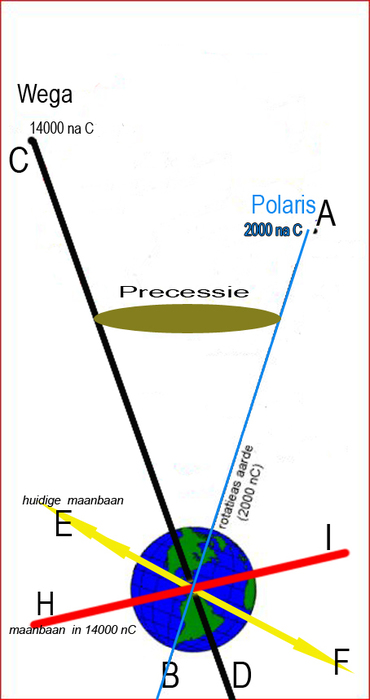Schilde, February 11, 2012
Madame, Sir,
Subject: Precession of the Earth’s axis and a possible shift of the Moon’s orbit around the Earth.
I would like an answer to the following question.
I am copying a text published on the Urania website for this purpose.
(http://www.urania.be/sterrenkunde/hemelmechanica/motions.php)
The tilt of the Earth’s axis, both relative to the lunar orbit (which forms an angle of about 5° with the ecliptic plane) and to the Earth’s orbit (23.5°), means that the gravitational pull of the moon (and also in to some extent the sun) cause the earth to make a slow spinning motion about the vertical on the ecliptic plane. The period of this toll movement, called the precession, is 25 770 years. As a result, the celestial north pole will describe a circular orbit around the ecliptic north pole with the same period. Since the position of the celestial north pole completely determines the position of the celestial equator, the latter also participates in the precession motion, and consequently also the vernal equinox, the intersection of celestial equator and ecliptic. The vernal equinox moves just over 50″ per year (360°/25770).
End quote.
Below you will find a drawing with the following information:
a) The line segment AB that indicates the current axis of the Earth in 2000 AD, with Polaris as pole star.
b) the line CD representing the axis of rotation of the Earth in 14000 AD. It then runs through Vega. The angle between CD and AB is about 47°. (i.e. 2 x 23.5°)
c) The yellow line segment EF represents the lunar orbit that makes an angle of approximately 5° with the ecliptic plane. i.e. this yellow line segment
an angle of about 85° with the Earth’s current axis of rotation AB . The yellow segment is therefore 5° above and below the solar tropics of 23.5°
The tropics of the moon thus form a band that fluctuates between 18.5° and 28.5°, above and below the equator.
Question: – if within 12,000 years the angle of the earth’s axis has shifted by about 47°, and the yellow segment simultaneously “does not” change direction, then the current angle between AB and EF will change from 85° to an angle of about 38° . Di the angle between EF and CD. This would mean that the moon could move much further north and south of the equator than it currently does. Currently I think this is between 18.5° and 28.5°, being 23.5 plus and minus 5°, above and below the equator. Within 12,000 years that would be 47° more or less. In other words, the moon fluctuates between the North Pole and South Pole circle. This could have very important consequences for:
the tolling movement of the earth’s axis (precession) and, for example, the tidal effect and all related matters.
– if, however, the 85° angle of the lunar orbit with the Earth’s axis were to be maintained, the lunar orbit would change from the current EF to the future red line HI. The angle between EF and HI is therefore also 47°. Then nothing would change with the precession movement and tidal action.
But what force can change the current lunar orbit EF to the lunar orbit HI in the year 12,000 AD?
Note: I have already posed this question to other specialists in the field. However, I have never received a reply.
Kind regards,
Dirk Heylen,
Prince Boudewijnlaan 47,
2970 Shield
Phone 03.383.46.09
Email: Hendrik.Heylen@telenet.be

Answer
Hi Dirk,
From what I understood from theoretical mechanics lessons, this 26 thousand year precession motion is not caused by the moon at all, nor by the sun. It can, of course, have some interesting interactions with it, such as changes in the tides. However, this precession motion is a fundamental aspect of any object that moves freely in space. Suppose you throw a brick through the air, it will also make a spinning motion. At any time you can determine a rotation axis around which the brick rotates. But that axis of rotation itself will also describe circles.
You can best see this phenomenon with a spinning top (one that stays on the ground with a point and that you drive with a rope). The top will rotate quickly around its axis, but in addition, the spinning top also describes circles around the tip with which it hits the ground. The second type of circles is caused by the fact that the shaft itself also rotates.
The same thing happens with the earth. Every day it revolves around its axis, while its axis itself describes a circle every 25 770 years. If the Earth is completely thrown out of its orbit by a passing giant planet, away from the sun and moon, the Earth will still continue to make the same precessions.
The different angles to the moon are therefore a result of this phenomenon, not a cause. Hopefully this answers your question.
Regards,
Ward
Answered by
Dr. Ir. Ward Blondé
Physics Bioinformatics
http://www.ugent.be
.